[Resource] Clinical Frailty Scale

The Clinical Frailty Scale (CFS) was introduced in the second clinical examination of the Canadian Study of Health and Aging (CSHA) as a way to summarize the overall level of fitness or frailty of an older adult after they had been evaluated by an experienced clinician (Rockwood et al., 2005).
Although introduced as a means of summarizing a multidimensional assessment in an epidemiological setting, the CFS quickly evolved for clinical use, and has been widely taken up as a judgement-based tool to screen for frailty and to broadly stratify degrees of fitness and frailty. It is not a questionnaire, but a way to summarize information from a clinical encounter with an older person, in a context in which it is useful to screen for and roughly quantify an individual’s overall health status.
The highest grade of the CFS (level 7) as published in 2005, incorporated both severe frailty and terminal illness. Later, it became evident that we needed to distinguish between identifiable groups who were otherwise lumped together in the original scale – severely frail, very severely frail and terminally ill - as clinically distinct groups who required distinctive care plans. Therefore, in 2007 the CFS was expanded from a 7-point scale to the present 9-point scale, and it has been used extensively in that format. We published on the predictive validity of the 9-point CFS in 2020 (Pulok et al., 2020).
In 2020 the CFS was further revised (version 2.0) with minor clarifying edits to the level descriptions and their corresponding labels. Most notably, CFS level 2 changed from "Well" to "Fit", level 4 from "Vulnerable" to "Living with Very Mild Frailty", and levels 5-8 were restated as "Living with..." mild, moderate, severe, and very severe frailty, respectively (Rockwood & Theou, 2020).
Please refer to the CFS Guidance and Training section of this website for more information and resources about using the Clinical Frailty Scale. For novice CFS raters, we developed a classification tree to assist with CFS scoring.
Visit resource here

-
By
Dalhousie University
-
Published
Mar 04, 2024
-
Subject Area
- Age-friendly Communities
- Health & Wellness - General
- Ageism
-
Audience
- Service Providers (Non-profits, Community Organizations, Local government)
- Government (Politicians, Policy Makers) and Health Authorities
- Funders
- Academics
- Caregivers, Seniors & Volunteers
- Government
- Health Authorities
-
Category
- CBSS Supports & Services
- Toolkits
- Provincial Resources
Newsletter
Sign up for the Healthy Aging CORE Alberta e-news to keep up-to-date with activity from the platform and the Community-Based Seniors Services (CBSS) sector across the province.
